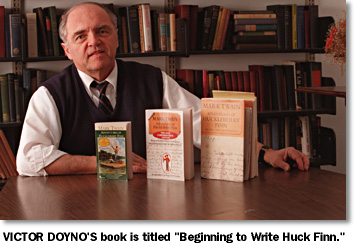
Doyno book will offer new findings on Twain's writing
By JESSICA ANCKER
Reporter Contributor
An expert on the writings of Mark Twain is extending his research on the manuscript of "Adventures of Huckleberry Finn," one of the seminal works of American literature.
 Victor Doyno, a professor in UB's English Department, has written and lectured extensively on Twain, whose real name was Samuel Clemens. Among Doyno's earlier books is the 1990 "Writing Huck Finn: Mark Twain's Creative Process," an analysis of the second half of the novel's manuscript, which at the time was the only portion known to have survived the author's death.
Victor Doyno, a professor in UB's English Department, has written and lectured extensively on Twain, whose real name was Samuel Clemens. Among Doyno's earlier books is the 1990 "Writing Huck Finn: Mark Twain's Creative Process," an analysis of the second half of the novel's manuscript, which at the time was the only portion known to have survived the author's death.
After the missing pages of the "Huck Finn" manuscript were rediscovered, Doyno helped prepare a new edition of the novel, published by Random House in 1996, that includes original material that had been edited out before the 1885 first publication.
Now Doyno is working on a study of the first portion of the "Huck Finn" manuscript. With the help of a grant from the National Endowment for the Humanities, Doyno spent a semester doing a scientific examination of the handwritten pages.
By comparing the pages with the paper Clemens used for his personal letters, Doyno determined the dates of undated portions of the manuscript. Doyno also learned to distinguish between the purple ink Clemens used for parts of the first draft and the faded gray ink in the corrections, revisions, and cancels he made later. Inspecting the manuscript under ultraviolet light also revealed differences between inks of different ages, as well as the texts of passages that Clemens crossed out when he was making revisions, Doyno says.
"I've 'solved' all the cancels by now, except for one passage that he canceled four times. I can't figure that one out," says Doyno.
These kinds of studies have allowed Doyno to follow the evolution of the text as the author revised and rewrote it, a field of scholarship known as "genetic studies."
Doyno's new findings will be published in his forthcoming book, "Beginning to Write Huck Finn." In addition, he is exploring the possibility of creating a CD-ROM containing the novel, a facsimile of the manuscript, and a large selection of critical essays and background information intended to help scholars and students.
"My main interest focuses on how this amazing American novel was written," Doyno says. "All these techniques are just tools to help learn about that central question."
The draft shows the meticulous care Clemens took to get his characters' dialects right. In page after page of Jim's dialogue, Clemens crossed out every "and" and "can" and substituted "en" and "kin."
Seemingly small revisions also can show how the author's own sense of the story changed as he was writing it.
One of these details comes during an important early moment in the novel when Jim reveals that he is running away from slavery. He begs Huck not to give him away, and Huck promises to keep the secret.
In his scrutiny of the manuscript, Doyno found that Clemens originally had Huck shake Jim's hand to seal the bargain. Later, Clemens crossed out the handshake.
Doyno points out that the change could have been caused by one of a number of reasons. Clemens may have considered the interracial handshake too progressive for 1845, which is when the story was set, or even for the 1880s, when it was published.
Or, Doyno says, Clemens may have realized as the story evolved that the handshake no longer made sense in light of one of the themes of the story, Huck's growing respect for Jim and his gradual acceptance of the former slave as a friend and an equal. A handshake so early in the story would have brought the two main characters together too early, too quickly, leaving little room for character growth.
While there always will be room for speculation about Clemens' thoughts and intentions, Doyno says such theories must be grounded in fact.
"It's important to make these factual determinations based on the manuscript before making an interpretation," Doyno says. "If you don't, there is a tendency to skew the facts to fit the interpretation."
![[Current Issue]](http://www.buffalo.edu/reporter/icons/Goto_Current.gif)
![[
Table of Contents ]](http://www.buffalo.edu/reporter/icons/TOC.gif)
![[
Search Reporter ]]( http://www.buffalo.edu/reporter/icons/Newspaper.gif)
![[Talk to
Reporter]](
http://www.buffalo.edu/reporter/icons/Phone.gif)
 Victor Doyno, a professor in UB's English Department, has written and lectured extensively on Twain, whose real name was Samuel Clemens. Among Doyno's earlier books is the 1990 "Writing Huck Finn: Mark Twain's Creative Process," an analysis of the second half of the novel's manuscript, which at the time was the only portion known to have survived the author's death.
Victor Doyno, a professor in UB's English Department, has written and lectured extensively on Twain, whose real name was Samuel Clemens. Among Doyno's earlier books is the 1990 "Writing Huck Finn: Mark Twain's Creative Process," an analysis of the second half of the novel's manuscript, which at the time was the only portion known to have survived the author's death.